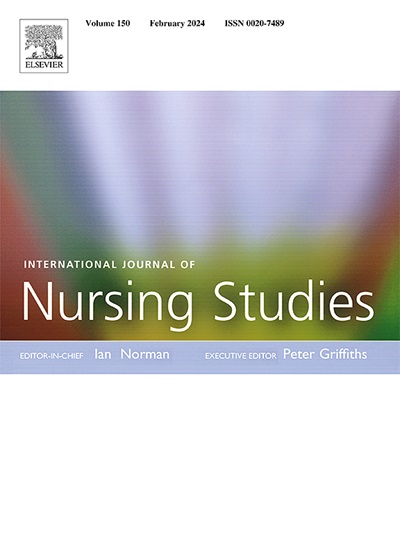护士主导的混合自我管理项目对社区居住的尿失禁老年人的有效性:一项随机对照试验
IF 7.1
1区 医学
Q1 NURSING
引用次数: 0
摘要
背景:循证指南推荐多组分干预,包括行为干预和生活方式干预,以优化老年人尿失禁的效果。然而,很少有研究在初级保健机构中使用混合(离线和在线)自我管理策略对社区居住的尿失禁老年人进行了这些干预措施的试验。目的评价护士主导的混合自我管理方案在社区老年尿失禁患者的自我效能感、尿失禁严重程度、尿失禁相关知识和态度、生活质量、骨盆底肌肉训练依从性、焦虑和抑郁方面的效果,并与现有常规护理方案进行比较。设计:采用重复测量设计的单盲、双臂平行随机对照试验。环境和参与者我们招募了居住在社区的轻度或中度尿失禁的老年人。方法将符合条件的参与者按1:1的比例随机分配到干预组(护士主导的混合自我管理计划)和常规护理组(常规护理)。在基线(T0)、基线后3个月(T1)和6个月(T2)测量结果。结果共招募66例受试者,随机分为干预组(N = 33)和常规护理组(N = 33)。其中95.5%的患者在干预结束后完成了3个月的随访。干预组自我效能感得分显著高于对照组(MD = 45.3, 95% CI: 38.9, 51.8, p <;0.001),尿失禁相关知识(MD = 10.5, 95% CI: 8.8, 12.2, p <;0.001),态度(MD = 4.1, 95% CI: 3.0, 5.1, p & lt;0.001)、生活质量(MD = 19.3, 95% CI: 15.4, 23.2, p & lt;0.001)和尿失禁严重程度评分较低(MD = 4.1, 95% CI: 2.8, 5.4, p <;0.001), T2时明显高于常规护理组。干预组高依从性盆底肌训练的比例显著高于常规护理组(33.3% vs 12.1%),风险差异(RD) = 0.21, 95% CI: 1.0, 12.9;χ2 = 4.23, p = 0.040)。然而,在焦虑方面没有统计学上的显著差异(MD = 0.3, 95% CI:−1.6)。0.9, p = 0.600)和抑郁(p >;0.05)。结论护士主导的混合自我管理方案对社区老年尿失禁患者的自我效能感、尿失禁严重程度、尿失禁相关知识和态度、骨盆底肌肉训练依从性和生活质量均有积极影响。中国临床试验注册中心(ChiCTR220005828,于2022年4月4日注册,首次招募于2022年4月10日,https://www.chictr.org.cn/showprojEN.html?proj=164661)。本文章由计算机程序翻译,如有差异,请以英文原文为准。
Effectiveness of a nurse-led hybrid self-management program for community-dwelling older people with urinary incontinence: A randomized controlled trial
Background
Evidence-based guidelines recommend multicomponent interventions including behavior interventions and lifestyle interventions to optimize effects on the urinary incontinence in older people. However, few studies have trialed these interventions led by nurses in primary care setting using hybrid (offline and online) self-management strategies for community-dwelling older people with urinary incontinence.
Objectives
To evaluate the effectiveness of a nurse-led hybrid self-management program on self-efficacy, severity of urinary incontinence, urinary incontinence related knowledge and attitude, quality of life, adherence to pelvic floor muscle training and anxiety and depression among community-dwelling older people with urinary incontinence, compared to the existing usual nursing care.
Design
A single-blind, two-arm parallel randomized controlled trial with a repeated measures design.
Settings and participants
We recruited community-dwelling older people with mild or moderate severity of urinary incontinence.
Methods
Eligible participants were randomly assigned (1:1) to either the intervention group (a nurse-led hybrid self-management program) or usual care group (usual nursing care) in the primary care. Outcomes were measured at baseline (T0), 3 months (T1) and 6-months (T2) post-baseline.
Results
Sixty-six participants were recruited and randomly assigned to the intervention group (N = 33) or the usual care group (N = 33). Of those, 95.5 % completed the 3-month follow-up after the completion of intervention. The intervention group demonstrated a statistically significant higher score of self-efficacy (Mean Difference (MD) = 45.3, 95 % CI: 38.9, 51.8, p < 0.001), urinary incontinence related knowledge (MD = 10.5, 95 % CI: 8.8, 12.2, p < 0.001), attitude (MD = 4.1, 95 % CI: 3.0, 5.1, p < 0.001), quality of life (MD = 19.3, 95 % CI: 15.4, 23.2, p < 0.001) and lower score of severity of urinary incontinence (MD = 4.1, 95 % CI: 2.8, 5.4, p < 0.001) than the usual care group at T2. The proportion with high adherence to pelvic floor muscle training was statistically significant larger in the intervention group than in the usual care group (33.3 % vs. 12.1 %, Risk Difference (RD) = 0.21, 95 % CI: 1.0, 12.9; χ2 = 4.23, p = 0.040) at T2. However, no statistically significant differences were observed in anxiety (MD = 0.3, 95 % CI: − 1.6. 0.9, p = 0.600) and depression (p > 0.05) at T2.
Conclusion
The nurse-led hybrid self-management program demonstrated positive effects on the self-efficacy, severity of urinary incontinence, urinary incontinence related knowledge and attitude, adherence to pelvic floor muscle training and quality of life for community-dwelling older people with urinary incontinence.
Trial registration
Chinese Clinical Trial Registry (ChiCTR220005828, Registered 04/04/2022, first recruitment 04/10/2022, https://www.chictr.org.cn/showprojEN.html?proj=164661).
求助全文
通过发布文献求助,成功后即可免费获取论文全文。
去求助
来源期刊
CiteScore
15.00
自引率
2.50%
发文量
181
审稿时长
21 days
期刊介绍:
The International Journal of Nursing Studies (IJNS) is a highly respected journal that has been publishing original peer-reviewed articles since 1963. It provides a forum for original research and scholarship about health care delivery, organisation, management, workforce, policy, and research methods relevant to nursing, midwifery, and other health related professions. The journal aims to support evidence informed policy and practice by publishing research, systematic and other scholarly reviews, critical discussion, and commentary of the highest standard. The IJNS is indexed in major databases including PubMed, Medline, Thomson Reuters - Science Citation Index, Scopus, Thomson Reuters - Social Science Citation Index, CINAHL, and the BNI (British Nursing Index).

 求助内容:
求助内容: 应助结果提醒方式:
应助结果提醒方式:


